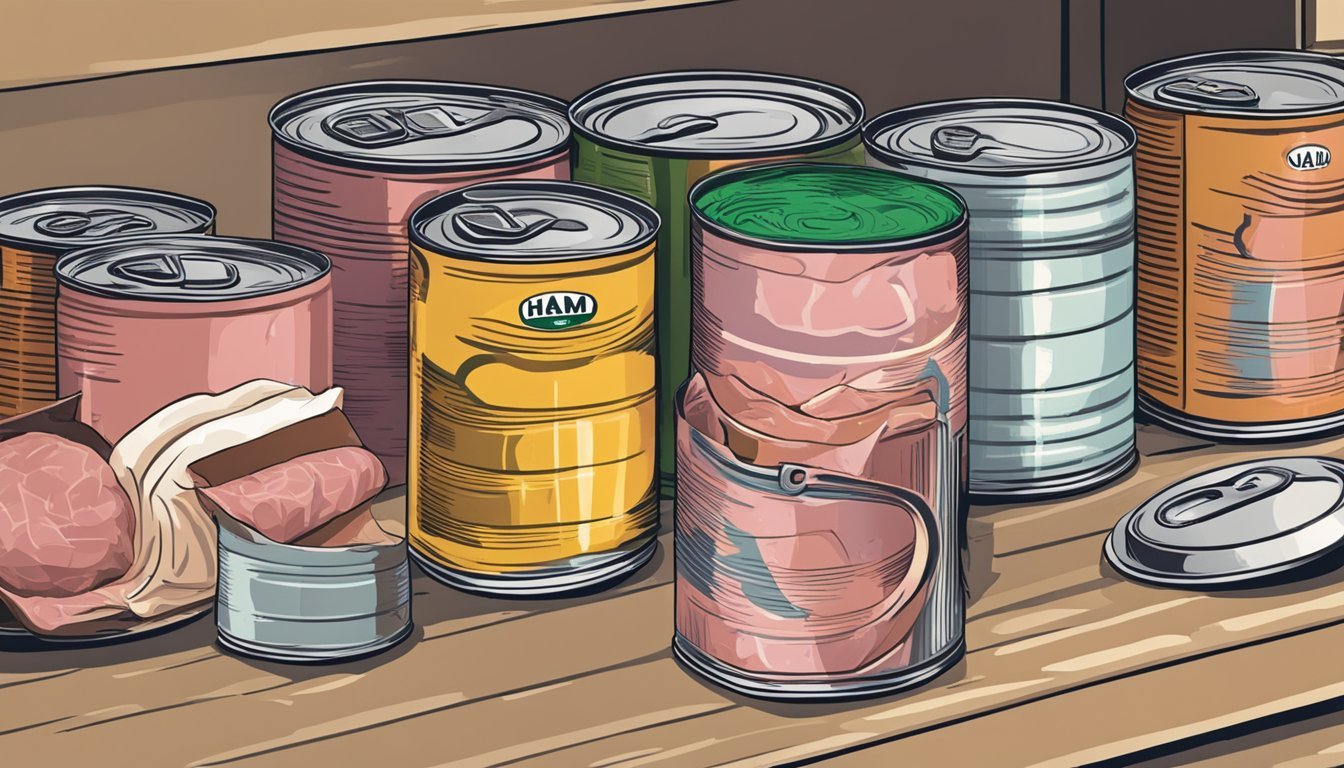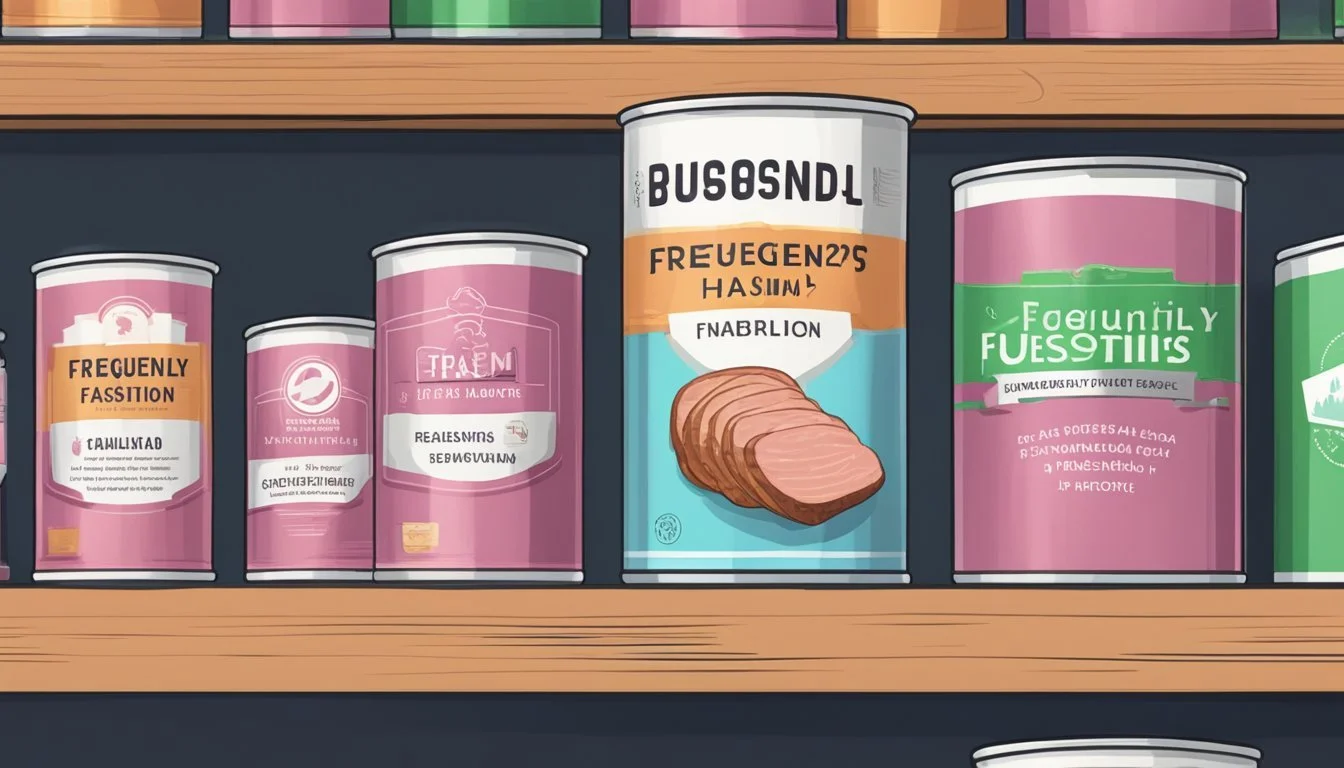How Long Does Canned Ham Last?
Unveiling Shelf Life and Storage Tips
Canned ham is a convenient option for those seeking a long shelf life and an easy-to-prepare meat source. Unlike fresh meat, which can spoil rapidly, canned ham has an extensive shelf life due to the canning process that seals the ham in a sterile environment. Shelf-stable canned hams, which can be stored at room temperature, typically last for up to two years when kept in a pantry. These hams are specially processed to be kept without refrigeration until they are opened.
However, not all canned hams are created equal. Some varieties require refrigeration and thus have a shorter shelf life. These refrigerated canned hams can be stored no longer than six to nine months in a refrigerator. The key to maximizing the shelf life of any canned ham is to store it under the right conditions—refrigerated or at room temperature according to the label, in a cool and dry place away from sunlight and fluctuating temperatures.
Understanding Canned Ham
Canned ham refers to ham that has been cured, sealed in a can, and then heat-processed to destroy pathogens and ensure long-term preservation. It's a convenient source of protein and can have varying levels of nutritional value based on ingredients and processing methods used. They typically contain ham, along with a combination of salt, sugar, and other preservatives that enhance flavor and texture while extending shelf life.
The quality of canned ham can remain consistent for quite some time. When unopened and stored in a cool, dry environment, shelf-stable canned ham can last up to two to five years. It should be noted though that even within this timeframe, the flavor may gradually diminish.
Storage methods play a crucial role:
Shelf-Stable: Can be stored at room temperature without spoiling for the duration of the indicated shelf life.
Refrigerated Types: Must be stored in the refrigerator and consumed within six to nine months.
Nutritionally, a canned ham can be a good source of protein but may be higher in sodium due to curing and preserving processes. While processed, some brands may include additional ingredients to enhance taste or shelf stability.
Assessing Texture: Over time, the texture of canned ham may change, though this does not necessarily mean the product is unsafe to consume. The ham generally remains safe past the 'best by' date but may not retain its optimal texture and flavor.
Flavor Profile: Canned ham often has a saltier taste compared to fresh ham due to the curing agents, which doubles as preservatives. The flavors imbued by these ingredients are a characteristic trait of canned hams.
Shelf Life and Expiration
Canned ham comes in varieties with differing storage expectations and timeframes for optimal quality. The expiration date, shelf life, and peak quality timelines are crucial for consumers to ensure the ham remains safe and enjoyable to consume.
Shelf-Stable Canned Ham
Shelf life:
Shelf-stable canned hams have a prolonged shelf life, allowing them to be safely stored at room temperature. They maintain best quality for:
Without opening: Typically up to 2 years from the packaging date, although some can last up to 5 years.
Best by dates: Should be adhered to as an indicator of peak quality.
Storage conditions:
To achieve this longevity, the canned ham must be kept in a cool, dry environment, away from direct sunlight or extreme temperature fluctuations.
Refrigerated and Frozen Ham
Refrigerated Canned Ham:
Unopened: Stores safely in the refrigerator for 6 to 9 months.
Best if used by dates: Indicate when the ham will likely be at its peak flavor and texture.
Frozen Ham:
Freezing: An option for extending the shelf life beyond the 'best if used by' period, though freezing can alter the texture.
Thawing: Should be done in the refrigerator to maintain safety.
Note: Label instructions on whether to refrigerate or not must be followed strictly to prevent spoilage.
Storage Guidelines
The longevity and safety of canned ham depend significantly on storage conditions before and after opening. One should store cans in cool, dry places, and keep opened ham refrigerated in airtight containers to maintain quality.
Before Opening
Shelf-Stable Canned Ham:
Storage: Should be stored at room temperature in a cool, dry place away from direct sunlight.
Duration: Can last up to two to five years, depending on the brand and storage conditions.
'Keep Refrigerated' Canned Ham:
Storage: Must be refrigerated immediately upon purchase.
Duration: Can be stored in the refrigerator for six to nine months.
After Opening
Shelf-Stable and Refrigerated Canned Ham:
Refrigeration: Once opened, both types must be transferred to the refrigerator.
Airtight Container: Opened ham should be kept in an airtight container to prevent contamination and drying out.
Duration: Consume opened canned ham within three to five days for best quality.
Freezing:
Option: If not consumed within the recommended time, one may freeze the ham.
Condition: Ensure it's wrapped tightly to prevent freezer burn.
Duration: Frozen ham can maintain quality for up to one to two months.
Identifying Spoilage
When evaluating the safety of canned ham, recognizing spoilage signs is crucial. It is important to note that once spoilage has occurred, consumption is not recommended and can pose health risks.
Visual Indicators:
Bulging: Cans showing a bulge could indicate bacterial growth and gas production, a clear sign of spoilage.
Rusting and Dents: While minor imperfections on a can are often harmless, severe dents, especially along seams, or rust that cannot be wiped away, can compromise the can's integrity and lead to spoilage.
Olfactory and Visual Clues:
Off Odor: Upon opening, any unpleasant or unusual odors suggest that the ham has gone bad.
Color Changes: Any discoloration or fading of the expected pinkish hue may indicate the presence of spoilage bacteria or mold.
Mold Presence: Visible mold, not a common occurrence in canned foods due to the sterile environment, is a definitive sign of contamination.
Can Integrity:
Leaking: Leakage is often a precursor to contamination and spoilage, resulting from breaches in the can's seal.
Consumers should inspect canned ham for these spoilage signs before consumption. If unsure, the safest course of action is to discard the product to avoid the risks of foodborne illness. When in doubt, it is always better to err on the side of caution.
Safe Consumption Practices
Canned hams are a convenient and long-lasting food option, but observing proper storage and safety practices is crucial for safe consumption. There are two main types of canned hams: shelf-stable and refrigerated.
Shelf-Stable Canned Hams:
Storage: They should be stored in a cool, dry place such as a pantry.
Safety Date: Typically safe to consume for up to 2 years, as long as the can remains in good condition, free from dents, rust, or swelling.
Refrigerated Canned Hams:
Storage: Must be kept in the refrigerator.
Safety Date: Generally safe to consume for 6 to 9 months while unopened.
Upon opening either type of canned ham:
Refrigeration: Leftovers should be refrigerated and consumed within a few days.
Safety: Inspect the ham for any signs of spoilage, including off-odors, discoloration, or mold before consumption, even before the safety date.
General Guidelines:
Always heed expiration dates, but remember that canned hams may be safe to consume after this date if they have been stored properly and show no signs of damage.
Opening: After opening, ensure that the ham is eaten within the recommended time frame to prevent foodborne illness.
For guaranteed safety, consumers should always follow the manufacturer's storage guidelines and use their discretion if a can seems compromised. Proper handling after opening is critical to maintaining food safety and quality.
Maximizing Ham Usability
To ensure the longevity and best use of canned ham, it's essential to understand the most effective ways to incorporate it into cooking and how to properly store leftovers.
Cooking and Recipes
When cooking with canned ham, one can create a variety of dishes that enhance its flavor and extend its usability. It is a versatile ingredient suitable for soups, stews, casseroles, and sandwiches. The key is to integrate the canned ham with complementary ingredients that will absorb its flavors and create a harmonious dish.
Suggested Recipes:
Ham and Bean Soup: A hearty combination where ham adds a smoky flavor.
Ham Casserole: Blend ham with pasta, cheese, and vegetables for a comforting meal.
Ham Sandwiches: Simple yet satisfying, using ham as the core protein.
Preserving Leftovers
For leftover canned ham, proper storage methods can significantly extend its post-open shelf life. Leftovers should be stored in the refrigerator, ideally within two hours of opening, and consumed within three to four days for best quality. Freezing leftover ham can extend its usability further, up to one month.
Freezing Tips:
Portion: Divide into user-friendly portions.
Wrap: Use airtight packaging, such as freezer bags or airtight containers.
Label: Always label with the freezing date for reference.
Reusing Leftovers: Leftover ham is perfect for reintegration into future meals. It can be diced and added to omelets, blended into spreads for appetizers, or even used to enrich the flavors of subsequent batches of soups and stews.
Health and Nutrition
Canned ham is a convenient protein source, offering a readily available addition to many meals. Protein is essential for building muscle, repairing tissue, and maintaining a healthy immune system. As a processed meat product, the nutritional value of canned ham may vary depending on the brand and the additives used during the curing process.
Nutrients typically found in canned ham include:
Protein: Essential for bodily functions and muscle maintenance.
Fat: Provides energy, with saturated fats present to consider in dietary intake.
Vitamins and Minerals: Some brands may be a source of iron and zinc, and B vitamins are often present due to the meat content.
When considering the nutritional aspects of canned ham, one should be aware of the sodium content. Cured meats like canned ham often contain high levels of sodium, which can lead to increased blood pressure and other health issues if consumed in excess.
To balance the nutritional intake, it's advisable to pair canned ham with:
Fresh vegetables
Whole grains
Fruit
These foods can help mitigate the higher sodium content while providing additional nutrients and fiber, contributing to a well-rounded diet. Regular consumption of processed meats is generally not recommended as a primary protein source. Alternatives such as fresh lean meats, poultry, fish, or plant-based proteins offer a broader spectrum of nutritional benefits with less sodium and additives.
Disposal and Donation
When determining how to handle excess canned ham, individuals must consider both disposal and donation options. Canned hams that are beyond their expiration dates or have shown signs of spoilage should be disposed of properly. Signs of spoilage include off odors, bulging cans, or any visible signs of mold. In such cases, one should err on the side of caution and dispose of the product to avoid health risks.
Disposal should be carried out as follows:
Remove the ham from the can.
Wrap the ham securely to prevent leakage.
Place it in a sealed bag.
Dispose of it in the garbage.
Donation of canned ham is a beneficial alternative if the product is unexpired and in good condition. Many food banks and shelters welcome donations of non-perishable food items:
Check the expiration date to ensure it’s suitable for donation.
Ensure the can is not damaged, rusted, or bulging.
Contact local food banks to verify need and acceptance criteria.
Donation Checklist Yes No Is the expiration date still valid? ✓ Is the can undamaged and sealed? ✓ Is the canned ham free of spoilage signs? ✓
Donors should be confident that their contribution is of good quality, thereby respecting the health and well-being of the recipients. It is important for donors to avoid donating items that they would not consume themselves. One should dispose of questionable items responsibly, ensuring they do not pose a health hazard to others.
Frequently Asked Questions
How long can canned ham last in storage?
Shelf-stable canned ham can last for 2 to 5 years when stored in a cool, dry place. Refrigerated canned hams should not be kept for more than 6 to 9 months in the refrigerator.
Can you consume canned ham past its expiration date?
Consuming expired canned ham is not recommended as the quality and flavor may diminish over time. It's advisable to adhere to the expiration date to ensure safety.
Are all canned hams shelf-stable?
Not all. Some canned hams require refrigeration and are labeled "Keep Refrigerated". They differ from shelf-stable varieties, which can be stored at room temperature.
What storage conditions are ideal for canned ham?
For shelf-stable canned ham, a cool, dry area is optimal. Keep refrigerated canned hams in the refrigerator immediately after purchase to maintain safety and quality.
Does canned ham's size affect its shelf life?
Generally, shelf-stable canned hams not exceeding 3 pounds have a longer shelf life, due to their processing method designed to eliminate spoilage bacteria and pathogens.
Additional Tips
When storing canned ham, which is a type of processed meat product, maintaining an optimal environment is crucial. An unopened can remains safe for a long duration due to the vacuum seal that prevents the entry of microorganisms. However, once opened, the protection is compromised, inviting bacteria that can spoil the product.
Storage Temperature: Always store canned ham in a cool and dry place to maintain quality. For shelf-stable varieties, a pantry works fine, whereas "Keep Refrigerated" types must stay in the fridge.
After Opening: Transfer any leftover canned ham to airtight containers and refrigerate promptly to prevent bacterial growth.
Environment Unopened Shelf-Stable Can Unopened "Keep Refrigerated" Can Pantry Up to 2 years Not Applicable Refrigerator Not Applicable 6 to 9 months
Prevent Contamination: After opening, ensure that the canned ham does not come into contact with utensils or containers that have touched raw meat products.
Avoid Exposure to Heat and Light: Heat can accelerate spoilage, and light exposure may degrade the quality faster.
Check Integrity: Before using, inspect the can for dents, rust, or swelling. These can be signs that the vacuum seal has been broken, which might lead to spoilage or contamination.
Discard Suspicious Cans: If the can emits an odd smell, a fizzing sound upon opening, or the meat product has an unusual appearance, discard it immediately to avoid the risk of foodborne illness.
Additionally, while canned goods like ham can last beyond their expiration dates, it is advisable to consume them closer to the date for optimal flavor and quality. Products such as SPAM follow similar guidelines, but always refer to the manufacturer’s recommendations for best practices.







